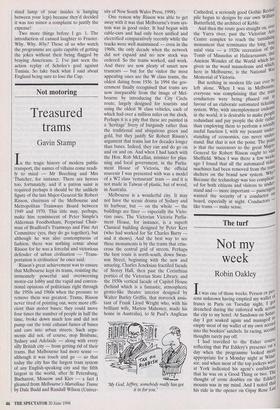Not motoring
Treasured trams
Gavin Stamp
In the tragic history of modem public transport, the names of villains come readi- ly to mind — Mr Beeching and Mrs Thatcher, for instance. There are heroes too, fortunately, and if a patron saint is required perhaps it should be the unlikely figure of the late Major-General Sir Robert Risson, chairman of the Melbourne and Metropolitan Tramways Board between 1949 and 1970. This title may, perhaps, make him reminiscent of Peter Simple's Alderman Foodbotham, Perpetual Chair- man of Bradford's Tramways and Fine Art Committee (yes, they do go together), but although he was also contemptuous of fashion, there was nothing comic about Risson for he was a forceful and victorious defender of urban civilisation — 'Trans- portation is civilisation' he once said.
Risson's great achievement was to ensure that Melbourne kept its trams, resisting the immensely powerful and overweening motor-car lobby and the vapid and conven- tional opinions of politicians right through the 1950s and 1960s when the pressure to remove them was greatest. Trams, Risson never tired of pointing out, were more effi- cient than motor buses; they could move four times the number of people in half the time, broke down much less and did not pump out the toxic exhaust fumes of buses and cars into urban streets. Such argu- ments did not, of course, stop Brisbane, Sydney and Adelaide — along with every silly British city — from getting rid of their trams. But Melbourne had more sense although it was touch and go — so that today the city has the largest tram system of any English-speaking city and the fifth largest in the world, after St Petersburg, Bucharest, Moscow and Kiev — a fact I gleaned from Melbourne's Marvellous Trams by Dale Budd and Randall Wilson (Univer- sity of New South Wales Press, 1998).
One reason why Risson was able to get away with it was that Melbourne's tram sys- tem was in good order. It had begun with cable-cars and had only been unified and electrified comparatively recently while the tracks were well maintained — even in the 1960s, the only decade when the network did not expand and no new stock was ordered. So the trams worked, and work. And there are now plenty of smart new tramcars — but for the visitor the most appealing ones are the W class trams, the oldest dating from 1936. In 1994 the gov- ernment finally recognised that trams are now inseparable from the image of Mel- bourne by introducing the City Circle route, largely designed for tourists and using the oldest W class vehicles, each of which had over a million miles on the clock. Perhaps it is a pity that these are painted in a 'heritage' livery of burgundy rather than the traditional and ubiquitous green and gold, but they justify Sir Robert Risson's argument that trams last for decades longer than buses. Indeed, they can and do go on and on and on. And when I had lunch with the Hon. Rob McLellan, minister for plan- ning and local government, in the Parlia- ment House of Victoria, the official souvenir I was presented with was a model of a W2 class 'restaurant' tram — and it is not made in Taiwan of plastic, but of wood, in Australia.
Melbourne is a wonderful city. It may not have the scenic drama of Sydney and its harbour, but — on the whole — the buildings are finer — especially the Victo- rian ones. The Victorian Victoria Parlia- ment House, for instance, is a superb Classical building designed by Peter Kerr (who had worked for Sir Charles Barry and it shows). And the best way to see these monuments is by the trams that criss- cross the central grid of streets. Perhaps the best route is north-south, down Swan- son Street, beginning with the new and amazing, Charles Jencksian fractiled facade of Storey Hall, then past the Corinthian portico of the Victorian State Library, and the 1930s vertical facade of Capitol House (behind which is a fantastic, atmospheric grotto-like theatre interior designed by Walter Burley Griffin, that maverick assis- tant of Frank Lloyd Wright who, with his brilliant wife, Marion Mahoney, made his home in Australia), to St Paul's Anglican My God, Jeffrey, somebody really has got it in for you.' Cathedral, a seriously good Gothic Revival pile begun to designs by our own William Butterfield, the architect of Keble. And then the route goes straight on, over the Yarra river, past the Victorian Alts Centre complex to reach the tantalising monument that terminates the long, long axial vista — a 1920s recreation of the Tomb of Mausolus at Halicarnassus, that Ancient Wonder of the World which has given us the word mausoleum and which, here in Melbourne, is the National War Memorial of Victoria. But nothing in modern life can ever be left alone. When I was in Melbourne' everyone was complaining that the tram conductors were being phased out in favour of an elaborate automated ticketing system. Why, with unemployment endemic in the world, it is desirable to make people redundant and pay people the dole rather than employing them to perform a socially useful function I, with my peasant under" standing of economics, can never under' stand. But that is not the point. The Point is that the successors to the great Main!: General Sir Robert Risson ought to visl' Sheffield. When I was there a few vveeks, ago I found that all the automated ticket machines had been removed from the train, shelters on the brand new system. VIY. Because the technology was too complicar° ed for both citizens and visitors to under" stand and — more important — passengers wanted the security of a conductor on board, especially at night. Conductors like trams — make sense.


























































 Previous page
Previous page